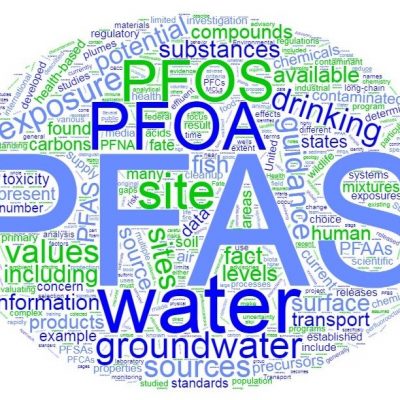New Soil and Groundwater Quality Guidelines from the Canadian Council of Ministers of the Environment and Implications for Contaminated Sites Assessment in Canada
The Canadian Council for Ministers of the Environment (CCME) released soil and groundwater quality guidelines (see Table below) for the protection of human and ecological health for perfluorooctane sulfonate (PFOS) on September 21, 2021.
CCME (2021) Soil Quality Guidelines for the Protection of Human and Ecological Health for Various Land Uses
| Agricultural | Residential/Parkland | Commercial | Industrial | |
| Soil Quality Guideline for Human Health* | 0.01 mg/kg | 0.01 mg/kg | 0.01 mg/kg | 0.01 mg/kg |
| Soil Quality Guideline for Environmental Health* | 0.01 mg/kg | 0.01 mg/kg | 0.2 (coarse soil) 0.1 fine soil |
0.2 (coarse soil) 0.1 fine soil |
*Additional details regarding pathway-specific guidelines and check values are provided within CCME (2021)
NR: Not required, NC: not calculated – should be considered on a site-specific basis. Fine soil: soil where more than 50% of the particles (by mass) are > 75 µm (mean) in diameter. Coarse soil: Soil where more than 50%, by mass, particles larger than 75 µm (mean) diameter.
CCME (2021) Groundwater Quality Guidelines for the Protection of Human and Ecological Health for Various Land Uses
| Agricultural | Residential/Parkland | Commercial | Industrial | |
| Groundwater Guideline for the protection of human health (GWQGpw) | 0.0006mg/L (fine and coarse soil) |
0.0006mg/L (fine and coarse soil) |
0.0006mg/L (fine and coarse soil) |
0.0006mg/L (fine and coarse soil) |
| Groundwater Quality Guideline for the Protection of Freshwater Life (Final GWQG) | 0.007 mg/L | 0.007 mg/L | 0.007 mg/L | 0.007 mg/L |
| Groundwater Contact By Soil-Dependent Organisms | 1 mg/L | 1 mg/L | 1 mg/L | 1 mg/L |
| Groundwater Ingestion (Livestock Watering) | 0.3 mg/kg | NR | NR | NR |
| Groundwater Protection of Irrigation Water | NC | NR | NR | NR |
(a) GWQG: Groundwater quality guideline. The final GWQC is the most conservative value of the non-human health related values, in this case, the freshwater aquatic life value.
(b) GWQGPW: The Groundwater Quality Guideline for the Protection of Potable Water is adopted directly from the Canadian Drinking Water Quality Guidelines. The drinking water guideline for PFOS of 0.0006 mg/L (Health Canada 2018) should be used for the evaluation of potable groundwater consumption.
PFOS and other per- and poly-fluoroalkyl substances (PFAS) have been (and some PFAS currently are still) used in various manufacturing processes and consumer products. The use of PFAS within aqueous film forming foams (AFFF) that are used at airports, military bases and by firefighting personnel at municipal and industrial organizations also include PFAS. As a result, PFAS may be present in the vicinity of certain industrial sites, former and current airport and military sites, landfills, wastewater and associated biosolids, and may co-occur with petroleum hydrocarbon or glycol contamination.
As PFOS is often detected in soil and groundwater with perfluorooctanoic acid (PFOA), the CCME (2021) guidance notes that the risks of the two compounds should be considered to be additive when detected in the same media (soil or groundwater). To estimate the additivity, CCME suggests the following approach:
| [PFOS concentration in soil or groundwater]
CCME Guideline for PFOS (soil or groundwater) |
+ | [PFOA concentration in soil or groundwater]
Applicable guideline for PFOA in soil or groundwater |
<1 |
The CCME (2021) notes that at the time of publication no soil quality or groundwater quality guidelines have been developed by the organization for PFOA. It is recommended that other applicable values for PFOA available from local jurisdictions or other agencies (e.g., Health Canada, Environment and Climate Change Canada or a provincial/territorial organization) be used in the estimation of additivity for the time being. It is emphasized that this additivity assumption is only applicable to PFOS and PFOA, and not to other PFAS compounds.
Health Canada has derived Drinking Water Quality Guidelines for both PFOS and PFOA (Health Canada 2019). Environment and Climate Change Canada finalized Federal Environmental Quality Guidelines for PFOS in 2018 for surface water, wildlife diet, fish tissue and bird eggs (ECCC 2018). In addition to these formal guidance values, Health Canada has also developed screening values for certain PFAS compounds (other than PFOA and PFOS) for soils and drinking water.
The latest CCME document (CCME 2021) is intended to provide generic guidance for use at contaminated sites in Canada relating to PFOS, and has been developed based on the CCME (2006) Protocol for the Derivation of Environmental and Human Health Soil Quality Guidelines. These values set an important precedent for assessment and management of contaminated sites in Canada. In light of the potential presence of PFAS in soil and groundwater at various contaminated sites in Canada and in the absence of enforceable PFAS environmental criteria in most provinces and territories, contaminated site liability in relation to PFAS is an emerging area in Canada. In the United States, several enforcement actions have been initiated in relation to PFAS contamination at the federal-and state-levels.
For more information, please contact us at:
1-403-237-0275 (Calgary)
1-905-364-7800 (Mississauga)
Resources

